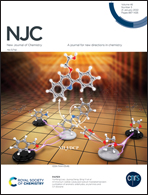A graphene-printed paper electrode for determination of H2O2 in municipal wastewater during the COVID-19 pandemic†
Abstract
Recently, hydrogen peroxide (H2O2) has been used as a disinfectant in sanitizers for cleaning hands, and solid surfaces of hospitals, offices and homes to prevent the spread of the COVID-19 virus. The effluents from domestic, hospital and municipal waste should be monitored for their H2O2 content to avoid the entry of this toxic pollutant into the ecosystem. Therefore, we developed a low-cost graphene (Gr)-printed paper electrode for determination of H2O2 using cyclic voltammetry (CV). An office inkjet-printer and Gr nano-ink stabilized with ethyl cellulose (EC) were used for the fabrication of printed paper electrodes (PPEs) to determine H2O2 quantitatively. A stable Gr–EC nano-ink (2%) with viscosity and surface tension values of 12 mPa S−1 and 35 mN M−1, respectively, was formulated to obtain conductive electrodes. A wide linear range (2 μM–25 mM) with a better limit of detection (0.28 μM) for the determination of H2O2 was obtained when the Gr–EC/PPE was used as a working electrode. Further, the Gr–EC/PPE was successfully employed for analysis of H2O2 in wastewater. The electrochemical determination of H2O2 using the Gr–EC/PPE as an electrode in CV is rapid, economical, flexible and eco-friendly when compared with previously reported methods.



 Please wait while we load your content...
Please wait while we load your content...